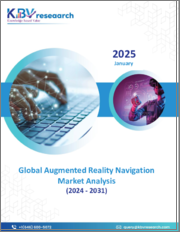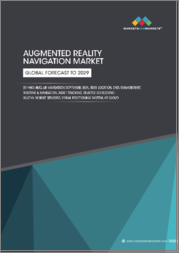
|
시장보고서
상품코드
1637980
세계의 증강현실 내비게이션 시장 : 규모 분석, 제공별, 용도별, 내장 모바일 센서별, 지역별, 예측(2022-2032년)Global Augmented Reality Navigation Market Size Study, by Offering, by Application, by Built-in Mobile Sensors, and Regional Forecasts 2022-2032 |
||||||
세계 증강현실 내비게이션 시장 규모는 2023년에 약 8억 3,000만 달러를 기록했습니다. 예측기간 2024-2032년 CAGR은 40.3%로 견조한 성장이 예측되고 있습니다.
증강현실(AR) 네비게이션은 현실 세계의 환경과 컴퓨터가 생성한 입력을 결합하여 실시간 위치 및 네비게이션 세부 정보를 제공하여 사용자 경험을 향상시킵니다. 이 기술은 AR 헤드 마운트 디스플레이(HMD) 및 헤드업 디스플레이(HUD)를 활용하여 핸즈프리로 몰입감 있는 네비게이션 솔루션을 실현합니다.
ADAS(선진 운전 지원 시스템)와 커넥티드 자동차 기술의 채용이 급증하고 있는 것이 특히 자동차 분야에서 시장을 뒷받침하고 있습니다. AR 네비게이션은 실시간 데이터 시각화와 직관적인 길 안내를 통합하여 안전성과 편의성을 높여 고급차 및 하이테크 차량에 빼놓을 수 없는 기능이 되고 있습니다. 마이크로소프트와 폭스바겐과의 제휴와 같은 전략적 제휴는 AR 네비게이션 시스템 개발에 대한 관심 증가를 뒷받침합니다.
또한 라우팅 및 네비게이션을 위한 AR 용도는 자동차 용도에 그치지 않고 쇼핑몰, 공항, 박물관 등 실내 네비게이션에서도 각광받고 있습니다. Navigine 및 SITUM Technologies와 같은 기업이 실내 AR 네비게이션 솔루션으로 혁신을 일으켜 이 부문의 성장을 가속하고 있습니다. Google Maps 및 Sygic GPS와 같은 모바일 기반 AR 네비게이션 앱은 GPS, AR 클라우드, 정확한 경로 안내 및 위치 추적을 위한 내장형 센서를 활용하여 개인 네비게이션 경험을 향상시킵니다.
AR 네비게이션은 5G 통합과 AI 주도의 기능 강화를 통해 큰 기회를 제공하는 한편, GPS 디바이스에의 의존이나 한정된 사용자에게 익숙해지는 과제가 장벽이 되고 있습니다. 그럼에도 불구하고 다양한 분야에서 네비게이션에 혁명을 일으키는 이 기술의 능력은 시장의 강력한 궤도를 보장합니다.
이 보고서에서 분석하는 주요 지역에는 북미, 유럽, 아시아태평양, 라틴아메리카 및 기타 유럽이 포함됩니다. 유럽은 기술 발전과 자동차 기술 혁신의 기반을 통해 시장을 선도하고 있으며, 아시아태평양은 AR 용도의 소비자 채용 증가와 도시 인프라 확대로 가장 빠른 성장을 기록할 것으로 예상됩니다.
목차
제1장 세계의 증강현실 내비게이션 시장 : 주요 요약
- 세계의 증강현실 내비게이션 시장 규모와 예측(2022-2032년)
- 지역별 개요
- 부문별 개요
- 제공별
- 용도별
- 주요 동향
- 경기 후퇴의 영향
- 애널리스트의 권고와 결론
제2장 세계의 증강현실 내비게이션 시장 : 정의와 분석의 전제
- 분석 목적
- 시장의 정의
- 분석의 전제
- 포함과 제외
- 제한 사항
- 공급측 분석
- 가용성
- 인프라
- 규제 틀
- 시장 경쟁
- 경제성(소비자의 시점)
- 수요측 분석
- 규제 틀
- 기술진보
- 환경 배려
- 소비자의 의식과 수용
- 분석 방법
- 분석 대상 기간
- 환율 변환율
제3장 세계의 증강현실 내비게이션 시장의 역학
- 시장 성장 촉진요인
- 실시간 위치 추적을 위한 AI 도입
- 커넥티드카와 자율주행차의 성장
- 도시 내비게이션 솔루션 수요 증가
- 시장의 과제
- GPS와 센서의 정밀도에 의존
- 유저의 익숙함과 한정된 수용
- 시장 기회
- 5G 기술과의 통합
- 신흥국의 확대
제4장 세계의 증강현실 내비게이션 시장 : 산업 분석
- Porter's Five Forces 모델
- 공급기업의 협상력
- 구매자의 협상력
- 신규 진입업자의 위협
- 대체품의 위협
- 경쟁 기업 간 경쟁 관계
- PESTEL 분석
- 정치적
- 경제적
- 사회적
- 기술적
- 환경적
- 법적
- 주요 투자 기회
- 주요 성공 전략
- 혁신의 동향
- 업계 전문가의 시점
- 애널리스트의 권고와 결론
제5장 세계의 증강현실 내비게이션 시장 규모와 예측 : 제공별(2022-2032년)
- 부문 대시보드
- 헤드 마운트 디스플레이(HMD)
- 헤드업 디스플레이(HUD)
- AR 네비게이션 소프트웨어
제6장 세계의 증강현실 내비게이션 시장 규모와 예측 : 용도별(2022-2032년)
- 부문 대시보드
- 실시간 위치 데이터 관리
- 라우팅·네비게이션
- 자산 추적
- 리버스 지오코딩
제7장 세계의 증강현실 내비게이션 시장 규모와 예측 : 지역별(2022-2032년)
- 북미
- 미국
- 캐나다
- 유럽
- 영국
- 독일
- 프랑스
- 스페인
- 이탈리아
- 아시아태평양
- 중국
- 인도
- 일본
- 호주
- 한국
- 라틴아메리카
- 브라질
- 멕시코
- 중동 및 아프리카
- 사우디아라비아
- 남아프리카
제8장 경쟁 정보
- 주요 기업의 SWOT 분석
- Google LLC
- Apple Inc.
- Microsoft
- 주요 시장의 전략
- 기업 프로파일
제9장 분석 프로세스
- 분석 프로세스
- 데이터 마이닝
- 분석
- 시장 예측
- 검증
- 출판
- 분석의 속성
The global augmented reality navigation market is valued at approximately USD 0.83 billion in 2023 and is projected to experience robust growth, achieving a healthy CAGR of 40.3% over the forecast period 2024-2032. Augmented reality navigation merges real-world environments with computer-generated inputs, enhancing user experiences by providing real-time location and navigation details. This technology leverages AR head-mounted displays (HMDs) and head-up displays (HUDs) for hands-free, immersive navigation solutions.
A surge in the adoption of advanced driver assistance systems (ADAS) and connected automotive technologies propels the market, particularly within the automotive sector. AR navigation enhances safety and convenience by integrating real-time data visualization with intuitive directions, making it a critical feature in luxury and high-tech vehicles. Strategic collaborations, such as Microsoft's partnership with Volkswagen, underscore the growing focus on AR navigation system development.
Moreover, AR applications for routing and navigation extend beyond automotive use, gaining prominence in indoor navigation for spaces like shopping malls, airports, and museums. Companies like Navigine and SITUM Technologies are innovating with indoor AR navigation solutions, boosting this segment's growth. Mobile-based AR navigation apps like Google Maps and Sygic GPS enhance personal navigation experiences by utilizing GPS, AR cloud, and built-in sensors for accurate path guidance and location tracking.
While AR navigation offers significant opportunities through 5G integration and AI-driven enhancements, challenges such as dependency on GPS devices and limited user familiarity present barriers. Nonetheless, the technology's ability to revolutionize navigation across various sectors ensures its strong market trajectory.
Key regions analyzed in this report include North America, Europe, Asia Pacific, Latin America, and the Rest of the World. Europe leads the market due to its technological advancements and automotive innovation hubs, while Asia Pacific is anticipated to register the fastest growth, driven by increasing consumer adoption of AR applications and expanding urban infrastructure.
Major market players included in this report are:
- Google LLC
- Apple Inc.
- Microsoft
- WayRay AG
- Neusoft Corporation
- Furuno Electric Co. Ltd.
- Treedis
- Arway Corp.
- Sygic
- IndoorAtlas
- Navigine
- ViewAR GmbH
- Esri
- Mapbox
- Resonai Inc.
The detailed segments and sub-segment of the market are explained below:
By Offering:
- HMD
- HUD
- AR Navigation Software
By Application:
- Real-Time Location Data Management
- Routing and Navigation
- Asset Tracking
- Reverse Geocoding
By Built-in Mobile Sensors:
- Visual Positioning System
- AR Cloud
By Region:
- North America
- U.S.
- Canada
- Europe
- UK
- Germany
- France
- Spain
- Italy
- ROE
- Asia Pacific
- China
- India
- Japan
- Australia
- South Korea
- RoAPAC
- Latin America
- Brazil
- Mexico
- Middle East & Africa
- Saudi Arabia
- South Africa
- RoMEA
Years considered for the study are as follows:
- Historical year - 2022
- Base year - 2023
- Forecast period - 2024 to 2032
Key Takeaways:
- Market Estimates & Forecast for 10 years from 2022 to 2032.
- Annualized revenues and regional-level analysis for each market segment.
- Detailed analysis of geographical landscape with country-level analysis of major regions.
- Competitive landscape with information on major players in the market.
- Analysis of key business strategies and recommendations on future market approach.
- Demand-side and supply-side analysis of the market.
Table of Contents
Chapter 1. Global Augmented Reality Navigation Market Executive Summary
- 1.1. Global Augmented Reality Navigation Market Size & Forecast (2022-2032)
- 1.2. Regional Summary
- 1.3. Segmental Summary
- 1.3.1. By Offering
- 1.3.2. By Application
- 1.4. Key Trends
- 1.5. Recession Impact
- 1.6. Analyst Recommendation & Conclusion
Chapter 2. Global Augmented Reality Navigation Market Definition and Research Assumptions
- 2.1. Research Objective
- 2.2. Market Definition
- 2.3. Research Assumptions
- 2.3.1. Inclusion & Exclusion
- 2.3.2. Limitations
- 2.3.3. Supply Side Analysis
- 2.3.3.1. Availability
- 2.3.3.2. Infrastructure
- 2.3.3.3. Regulatory Environment
- 2.3.4. Demand Side Analysis
- 2.3.4.1. Consumer Awareness & Acceptance
- 2.3.4.2. Technological Advancements
- 2.4. Estimation Methodology
- 2.5. Years Considered for the Study
- 2.6. Currency Conversion Rates
Chapter 3. Global Augmented Reality Navigation Market Dynamics
- 3.1. Market Drivers
- 3.1.1. Adoption of AI for real-time location tracking
- 3.1.2. Growth in connected and autonomous vehicles
- 3.1.3. Rising demand for urban navigation solutions
- 3.2. Market Challenges
- 3.2.1. Dependence on GPS and sensor accuracy
- 3.2.2. Limited user familiarity and acceptance
- 3.3. Market Opportunities
- 3.3.1. Integration with 5G technologies
- 3.3.2. Expansion in emerging economies
Chapter 4. Global Augmented Reality Navigation Market Industry Analysis
- 4.1. Porter's 5 Force Model
- 4.1.1. Bargaining Power of Suppliers
- 4.1.2. Bargaining Power of Buyers
- 4.1.3. Threat of New Entrants
- 4.1.4. Threat of Substitutes
- 4.1.5. Competitive Rivalry
- 4.2. PESTEL Analysis
- 4.2.1. Political
- 4.2.2. Economical
- 4.2.3. Social
- 4.2.4. Technological
- 4.2.5. Environmental
- 4.2.6. Legal
- 4.3. Top Investment Opportunities
- 4.4. Top Winning Strategies
Chapter 5. Global Augmented Reality Navigation Market Size & Forecasts by Offering 2022-2032
- 5.1. Segment Dashboard
- 5.2. HMD
- 5.3. HUD
- 5.4. AR Navigation Software
Chapter 6. Global Augmented Reality Navigation Market Size & Forecasts by Application 2022-2032
- 6.1. Segment Dashboard
- 6.2. Real-Time Location Data Management
- 6.3. Routing and Navigation
- 6.4. Asset Tracking
- 6.5. Reverse Geocoding
Chapter 7. Global Augmented Reality Navigation Market Size & Forecasts by Region 2022-2032
- 7.1. North America
- 7.1.1. U.S.
- 7.1.2. Canada
- 7.2. Europe
- 7.2.1. UK
- 7.2.2. Germany
- 7.2.3. France
- 7.2.4. Spain
- 7.2.5. Italy
- 7.3. Asia Pacific
- 7.3.1. China
- 7.3.2. India
- 7.3.3. Japan
- 7.3.4. Australia
- 7.3.5. South Korea
- 7.4. Latin America
- 7.4.1. Brazil
- 7.4.2. Mexico
- 7.5. Middle East & Africa
- 7.5.1. Saudi Arabia
- 7.5.2. South Africa
Chapter 8. Competitive Intelligence
- 8.1. Key Company SWOT Analysis
- 8.1.1. Google LLC
- 8.1.2. Apple Inc.
- 8.1.3. Microsoft
- 8.2. Top Market Strategies
- 8.3. Company Profiles
Chapter 9. Research Process
- 9.1. Research Process
- 9.1.1. Data Mining
- 9.1.2. Analysis
- 9.1.3. Market Estimation
- 9.1.4. Validation













